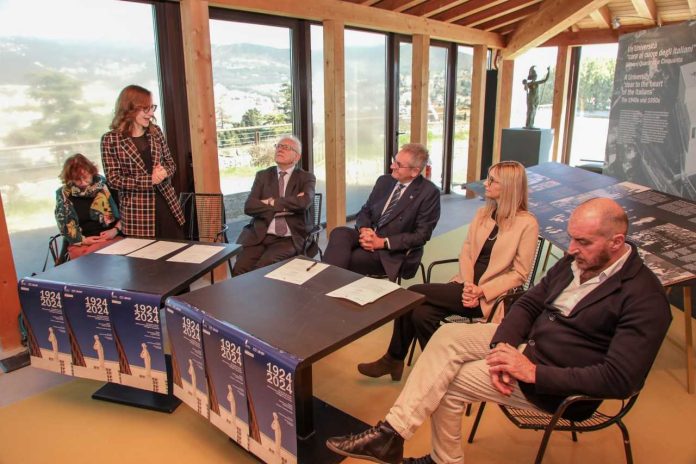by InTrieste
For the Centenary celebrations of the University, a grand exhibition titled “1924 – 2024: A Century of History at the University of Trieste: Images and Documents” was inaugurated at the Bastione Fiorito of the San Giusto Castle, a collaboration between the University of Trieste and the Municipality of Trieste. Spearheaded by the SMATS – University Museum System, the showcase received support from the Autonomous Region of Friuli Venezia Giulia.
Councilor Giorgio Rossi remarked, “With this exhibition, the Bastione Fiorito’s new exhibition season, overseen by the conservator of San Giusto Castle, continues to unfold. It’s a season dedicated to exploring the rich history and achievements of Trieste.” The exhibition, marking the University of Trieste’s Centenary, solidifies the partnership between the University and the Municipality on Capitol Hill.
Rector Roberto Di Lenarda expressed, “Visitors will gain a profound understanding of our proud custodianship of the city’s historical, architectural, and cultural heritage. Many will embark on a journey through the past, discovering lesser-known facets of our university.”
Tullia Catalan, the exhibition’s curator and associate professor of contemporary history at the University of Trieste’s Department of Humanities, emphasized the University’s desire to be at the heart of the city’s cultural and economic landscape. She noted the exhibition’s role in strengthening the bond between Trieste and academia, fostering an environment conducive to embracing dynamic changes in research, education, and professional spheres.
Under the stewardship of Anna Krekic, conservator of San Giusto Castle, and Laura Sartori, Centenary activities coordinator, the exhibition offers a narrative weaving through history, architecture, and art. Curated by Lorenzo Michelli, it unfolds in four distinct sections, blending historical sources with aesthetic references.
The first section, overseen by Tullia Catalan and Lorenzo Ielen, chronicles the University’s tumultuous journey over a century, showcasing archival materials from the University’s Historical Archive and various public and private collections. From navigating border disputes to embracing international openness in research and scientific disciplines, the University’s evolution reflects Trieste’s own transformative narrative.
The second section, curated by Paolo Nicoloso and Marko Pogacnik, delves into the architectural significance of the University’s central building, designed in 1938. Through technical drawings and imagery, the section unveils the intricate symbolism embedded in its design, including the iconic Minerva statue sculpted by Marcello Mascherini, symbolizing the University’s enduring legacy.
The third section, curated by Massimiliano Spanu and Daniele Terzoli, focuses on audiovisual elements, enriching the exhibition with the screening of valuable documentaries and footage. Of particular significance and beauty is the rediscovered film – thus restored to the annals of Italian cinema history – titled “Pagine d’Università,” shot in Ferraniacolor (a color cinematography process developed in Italy by Ferrania) in 1956 by Anna Gruber, a renowned Triestine actress, director, screenwriter, and internationally acclaimed author. Commissioned by the University Cinematography Center, the film was rediscovered in the A. Hortis Civic Library – Diplomatic Archive and Archival Funds.
Other film excerpts featured in the exhibition are sourced from the Historical Archive of Istituto Luce and from La Cineteca del Friuli – Archivio Cinema del Friuli Venezia Giulia. Archival research was conducted in collaboration with the research center La Cappella Underground.
The fourth and final section, curated by Massimo Degrassi and Lorenzo Michelli, delves into the history of art, showcasing a selection of works – now housed in the Rectorate Art Gallery – exhibited in 1953 at the National Exhibition of Contemporary Italian Painting held at the University of Trieste. The concluding part of the exhibition presents a selection of works donated to the University by thirty-five artists and collectors in honor of the Centenary, some of which were previously featured in the event “A Trieste mi piaceva arrivare” on December 20, 2023.
The exhibition will be open to the public from March 15 to September 1, 2024. From the opening until March 31, it will be open for visitation from Tuesday to Sunday, from 10:00 AM to 5:00 PM; from April 1 to September 1, it will be open daily from 10:00 AM to 7:00 PM.
Admission to the exhibition is included in the ticket to San Giusto Castle (full price 6 euros; reduced price 4 euros).
For more information, visit: castellodisangiustotrieste.it





























